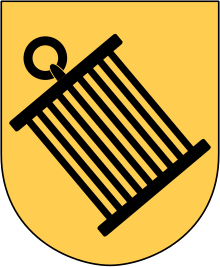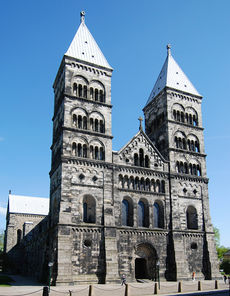Diocese of Lund
Diocese of Lund Lunds stift | |
|---|---|
 Arms of the diocese of Lund. It shows a gridiron in remembrance of the martyrdom of Saint Lawrence, the patron saint of Lund Cathedral. | |
| Location | |
| Deaneries | 18 kontrakt[1] |
| Coordinates | 55°42′15″N 13°11′37″E / 55.70417°N 13.19361°ECoordinates: 55°42′15″N 13°11′37″E / 55.70417°N 13.19361°E |
| Statistics | |
| Parishes | 155[1] |
| Congregations | 189[1] |
| Information | |
| Denomination | Church of Sweden |
| Established | around 1050[2] |
| Cathedral | Lund Cathedral |
| Current leadership | |
| Bishop | Johan Tyrberg |
| Map | |
 | |
| Website | |
| www | |
Archdiocese of Lund Archidioecesis Lundensis Lund ærkebispedømme | |
|---|---|
 Lund Cathedral, the seat of the Archbishop of Lund. | |
| Location | |
| Country | Denmark (present day Sweden) |
| Ecclesiastical province | Lund |
| Information | |
| Denomination | Roman Catholic |
| Sui iuris church | Latin Church |
| Rite | Roman Rite |
| Established | 1048 (As Diocese of Lund) 1103 (As Archdiocese of Lund) |
| Dissolved | 1536 |
| Cathedral | Lund Cathedral |
The Diocese of Lund (Swedish: Lunds stift) is a former Roman Catholic bishopric and archbishopric with see in Lund, southern Scandinavia. At the time of the Danish Reformation, it became a diocese in the Lutheran Church of Denmark, and since the signing of the treaty of Roskilde in 1658 it has been the southernmost diocese in the Lutheran Church of Sweden.
The territory of the present Lutheran diocese corresponds to the provinces of Blekinge and Skåne. There are 217 parishes within the diocese, the largest number in any of the dioceses of the Church of Sweden. The present bishop of Lund, Johan Tyrberg, succeeded Antje Jackelén in 2014.
Catholic History[]
The Latin Diocese of Lund was formed in 1060, in what was then Danish territory, by separation from the Diocese of Roskilde, then both suffragans of the German Archdiocese of Hamburg-Bremen. The provinces of (north-western) Skåne and Halland were under its jurisdiction.
The two other provinces of the Scanian lands, Blekinge and Bornholm, were, on the other hand, initially under the jurisdiction of the nearby Diocese of Dalby. At the earliest in 1067, the Dalby diocese was however merged into the Lund diocese.
In 1104, the diocese became the Metropolitan Archdiocese of Lund with its own ecclesiastical province, initially covering Denmark, Norway and Sweden. Norway got its own Archbishop of Nidaros in 1152, and Sweden its Archbishop of Uppsala in 1164, although the Swedish archbishop remained for a long time nominally subordinate to the Archbishop of Lund.
In January 1553, the Catholic see was suppressed, never to be restored. Instead, Sweden (and all Scandinavia) came under the vast Germany-based Apostolic Vicariate of Nordic Missions, until 1793 the Apostolic Prefecture of Sweden was created from it, soon promoted to Apostolic Vicariate (from which Norway was detached on 1868.08.07 as Mission sui juris, to become the Oslo bishopric), on 1953.06.29 promoted as Roman Catholic Diocese of Stockholm, still covering the whole country.
Lund's former Catholic cathedral see became a Protestant church.
Lutheran diocese[]
At the time of the Reformation in 1536, the office of archbishop was abolished in Denmark and Lund was demoted to an ordinary diocese. Initially, the Lutheran bishops were styled superintendents.
In 1658 Lund, together with the Scanian lands, fell under the government of Sweden (never to be reclaimed, except for short intervals during later wars), and Lund became subordinate to the Archbishop of Uppsala.
See also[]
References[]
- ^ a b c "Församlingar i Lunds stift" (in Swedish). Church of Sweden. Retrieved 26 August 2011.
- ^ "Lunds stift". Nationalencyklopedin (in Swedish). Retrieved 26 August 2011. (subscription required)
Sources and external links[]
- Official website
- article Lunds stift from Nordisk Familjebok, in Swedish
- Herbermann, Charles, ed. (1913). . Catholic Encyclopedia. New York: Robert Appleton Company.
- GCatholic with incumbent bio links
- Diocese of Lund
- Dioceses of the Church of Sweden
- Lund
- 1060 establishments in Europe
- Scania
- Formerly papal dioceses established in the 11th century
- Former Catholic dioceses in Sweden
- Former Catholic dioceses in Denmark

